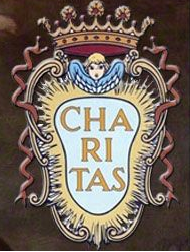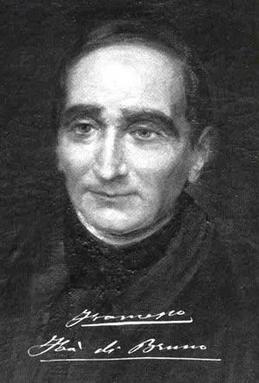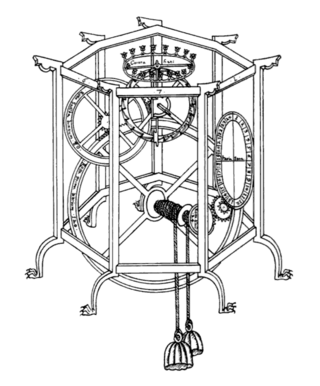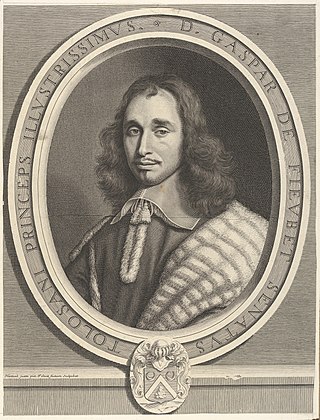
André-Marie Ampère was a French physicist and mathematician who was one of the founders of the science of classical electromagnetism, which he referred to as "electrodynamics". He is also the inventor of numerous applications, such as the solenoid and the electrical telegraph. As an autodidact, Ampère was a member of the French Academy of Sciences and professor at the École polytechnique and the Collège de France.

Marin Mersenne, OM was a French polymath whose works touched a wide variety of fields. He is perhaps best known today among mathematicians for Mersenne prime numbers, those written in the form Mn = 2n − 1 for some integer n. He also developed Mersenne's laws, which describe the harmonics of a vibrating string, and his seminal work on music theory, Harmonie universelle, for which he is referred to as the "father of acoustics". Mersenne, an ordained Catholic priest, had many contacts in the scientific world and has been called "the center of the world of science and mathematics during the first half of the 1600s" and, because of his ability to make connections between people and ideas, "the post-box of Europe". He was also a member of the ascetical Minim religious order and wrote and lectured on theology and philosophy.

Gerrit Janszoon Vos, often known by his Latin name Gerardus Vossius, was a Dutch classical scholar and theologian.
William of Moerbeke, O.P., was a prolific medieval translator of philosophical, medical, and scientific texts from Greek into Latin, enabled by the period of Latin rule of the Byzantine Empire. His translations were influential in his day, when few competing translations were available, and are still respected by modern scholars.

The Minims, officially known as the Order of Minims, and known in German-speaking countries as the Paulaner Order, are a Roman Catholic religious order of friars founded by Francis of Paola in fifteenth-century Italy. The order soon spread to France, Germany and Spain, and continues to exist today.

Francis of Paola, OM, was an Italian Catholic friar and the founder of the Order of Minims. Unlike the majority of founders of men's religious orders, and like his patron saint Francis of Assisi, he was never ordained a priest.

Francesco Faà di Bruno was an Italian priest and advocate of the poor, a leading mathematician of his era and a noted religious musician. In 1988 he was beatified by Pope John Paul II. He is the eponym of Faà di Bruno's formula.

Aubeterre-sur-Dronne, commonly referred to as Aubeterre, is a commune in the Charente department in the Nouvelle-Aquitaine region of Southwestern France.

The Church of Santissima Trinità dei Monti, often called simply Trinità dei Monti, is a Roman Catholic late Renaissance titular church in Rome, central Italy. It is best known for its position above the Spanish Steps which lead down to the famous Piazza di Spagna. The church and its surrounding area are a French State property.

Giovanni Dondi dall'Orologio, also known as Giovanni de' Dondi, was an Italian physician, astronomer and mechanical engineer in Padua, now in Italy.
Jean-Pierre Nicéron was a French lexicographer.

Martín de Azpilcueta, or Doctor Navarrus, was an important Spanish canonist and theologian in his time, and an early economist who independently formulated the quantity theory of money in 1556.
Jean-François Niceron was a French mathematician, Minim friar, and painter of anamorphic art, on which he wrote the ground-breaking book La Perspective Curieuse.

Anna Carlotta Teresa Canalis di Cumiana was a playwright and the morganatic wife of Victor Amadeus II, King of Sardinia. She was created Marchesa of Spigno.

Pierre Grégoire (c.1540–1597) was a French jurist and philosopher

San Francesco di Paola is a Baroque style, Roman Catholic church located on Via Manzoni in Milan, Italy.

Santissimo Crocifisso is a Catholic church in Alcamo, in the province of Trapani, Sicily, southern Italy.

Luigi Novarini was an Italian theologian and scholar.

Gaspard de Fieubet was a French magistrate. He served as president of the Parlement of Toulouse from 1653 to 1686, hailing from a prominent family in the legal and financial spheres. The Fieubet family had two branches: one in Paris and one in Toulouse; Gaspard de Fieubet was a distinguished member of the Toulouse branch.
















